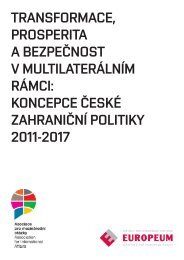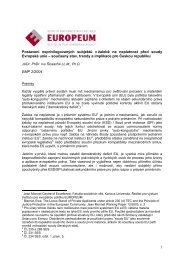eu constitutionalisation - EUROPEUM Institute for European Policy
eu constitutionalisation - EUROPEUM Institute for European Policy
eu constitutionalisation - EUROPEUM Institute for European Policy
Create successful ePaper yourself
Turn your PDF publications into a flip-book with our unique Google optimized e-Paper software.
Chapter 2: The Convention and IGC Texts of the ConstitutionThe IGC was a low cost exit option that permitted the governments to havea second chance to re-open and discuss again some issues they acceptedunwillingly. If we understand the <strong>for</strong>mal and substantial equality of theactors involved as a fundamental pre-condition <strong>for</strong> an effective deliberativesetting, this favourite position of governments has entailed a shift inthe relation amongst the actors, relatively compromising the deliberativeaspirations of this body.The Convention lost much of its deliberative attributes because it wasconceived as a deliberative interstice between two intergovernmentalmeetings: Laeken and the IGC of 2003/4. The room of mano<strong>eu</strong>vre of theassembly was compressed between two moment; one in which the Statesset up the mandate with clear constraints and another, the IGC, in whichthe States would have regained autonomy by scrutinising the final productof the Convention. The governments also profited of political resourcesoutside the Convention as they were constantly negotiating and buildingcoalition through their Ministry of Foreign affairs, their ambassadors, theCOREPER, the <strong>European</strong> Council. This is quite evident if we look to theseveral important joint proposals that some governments tabled at theConvention and that had a substantial impact on the final outcome.¹⁹Chapter 2: The Convention and IGC Texts of the ConstitutionThe institutional design of the Convention was expected to produce a morediscursive environment able to overcome the disease of the lowest commondenominator. The idea lying behind was that a more inclusive assemblywith a wide range of actor should have fostered deliberation. Most ofconstructivist approaches²² are often biased in favour of an overestimationof the discourse supporting characters of the institutional variables in factthere could be some doubts that the institutional design variable cannotcarry the entire explanatory workload. We must acknowledge in fact thatduring the Convention the institutional context has remained unchanged(the Convention and its organizational structure) but on the contrary thedynamic of negotiation has changed and so did the influence of the actors.To explain this exponential variation we need to consider also the policyvariable as an intervening variable that completes the analysis.²³There<strong>for</strong>e it is plausible to <strong>for</strong>mulate the hypothesis according to whichthe strategy, the way of action and the influence of the actors are not onlysignificantly influenced by the institutional context of the negotiations (inour case the Convention) but are also influenced by the resources that theactors were able to mobilise according to the issue and its political saliencyVs technicality-complexity²⁴.The importance of the policy variablesThe negotiating context of a specific EU constitutional negotiation mattersbecause it determines the extent of the collective action²⁰problemand whether an actor possess a privileged institutional position and theopportunities to translate the resources into influence.There<strong>for</strong>e, the institutional set up of the negotiation can matter in that actorscan start with or gain a privileged position during the negotiation that canbe exploited to influence the outcome.²¹19) Contribution conjointe franco-allemande sur la Gouvernance economique (CONV 470/02), Propositionsconjointes franco-allemandes dans le doamine de la justice et des affaires intéri<strong>eu</strong>res (CONV 435/02),Propositions conjointes franco-allemandes pour la Convention <strong>eu</strong>ropéenne dans le domaine de lapolitique <strong>eu</strong>ropéenne de securité et de défense (CONV 422/02), Contribution franco-allemande surl’architecture institutionnelle de l’Union (CONV 489/03), Contribution anglo-espagnole sur l’architectureinstitutionnelle de l’Union (CONV 591/03), Contribution “Re<strong>for</strong>ming the institutions: principles andpremises” (CONV 646/03)20) ZARTMAN and RUBIN (2000).21) BEACH (2003).Tab. № 1Independent variables Intervening variable Dependent variableProperty of the issue at stake:Political saliency Vstechnicality/complexityInstitutional andorganisational contextDomestic political contextNegotiation strategyand influenceThe hypothesis is that the properties and the characteristic of the issues areasthat was debated not only has entailed a different dynamics of interactionamongst the members but that in the case of low political saliency issuesthe Convention has managed to produce a stable consensus, whereas inhigh political saliency issues areas in which a bargaining style has emerged,the Convention did not manage to produce a stable consensus buta compromise that was reopened during the IGC²⁵. Classifying the issues22) See CHECKEL (2001), MAURER (2003), RISSE (2003).23) MAGNETTE (2004).24) BEACH (2003).25) POLLAK (2004).56 57








